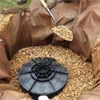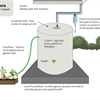
Dry wells and cisterns are both stationary, permanent stormwater collection structures that should be installed by a professional landscape engineer. Only one residential stormwater credit can be taken for utilizing a dry well or cistern. The
credit savings is $8.10 per quarter.
Dry wells are underground structures that store water in the void space between crushed stone or gravel and allow the water to slowly percolate downward into the subsoil. They are best able to handle smaller storms and must include some kind of overflow design.
A cistern, similar to a rain barrel but much larger, is built to catch and store rainwater for irrigation during dryer periods. Cisterns may be located underground, at ground level or on elevated stands.
- Can reduce total stormwater runoff volume.
- Allow captured water to slowly percolate downward into the subsoil.
- Installed by digging a deep hole and setting up a perforated tank.
- Gravel is usually placed around the outside of the tank and a lid put on top.
- Receives water from one or more entry pipes or channels at its top. Discharges the same water through a number of small openings on the sides and bottom into the soil that surrounds it.
- Because of their limited size, dry well structures are best used to infiltrate the first inch/half inch of runoff from frequent small storms. They are not effective for infiltrating the runoff from large storms.
- Dry wells must be equipped with an overflow or bypass device to divert runoff in excess of their capacity without causing erosion and/or property damage.
- The excavated hole, 3 to 12 feet deep, must be lined with filter fabric and backfilled with washed, crushed stone 1.5 to 3 inches in diameter.
- The dry well must be lined with a material that provides void space. The simplest method is to use perforated drain tile. Premanufactured concrete rings with holes in them are also available. The rings are typically 3 feet high and 6 feet in diameter. The dry well may be buried completely, so that it does not take up any land area.
- Where dry wells accept roof runoff through a system of gutters and downspouts, screens must be installed at the top of downspouts.
- Runoff from paved surfaces must pass through a grass swale or filter strip to pretreat stormwater before it is discharged to the dry well.
Stormwater utility credit — dry well
Installing a dry well can result in a savings of $8.10 per quarter. Only one residential stormwater credit can be taken for utilizing a dry well or cistern. The requirements for a stormwater utility credit are:
- Roof Drainage:
- At least 50% of your property’s roof area should drain to the dry well.
or - The dry well must capture runoff from impervious areas on your property that are equal to 50% of your roof area.
- Size:
- 66 cubic feet, or 500 gallons of capacity
- Infiltration:
- A full dry well must completely infiltrate into the ground within 24 hours.
Other recommendations:
- Test the ground before installing:
- Dig an 18-inch hole and fill it with water.
- Let it drain entirely.
- Fill again. If the second time it takes less than 24 hours to drain, the soils are adequate for the dry well.
Once you have installed a dry well on your property, contact the city at
[email protected] with a description, including photos if necessary, and address.
A cistern is a receptacle built to catch and store rainwater for irrigation during dryer periods. While they are similar to rain barrels in purpose, cisterns are usually much larger. Cisterns may be located underground, at ground level or on elevated stands.
It is recommended that cisterns be watertight, have smooth interior surfaces, enclosed lids and be large enough to provide adequate storage.
Cisterns should be fabricated from nonreactive materials such as reinforced concrete, galvanized steel and plastic.
Specifics for belowground cistern installation:
- Excavate the hole to the required dimensions - for example, 8 feet by 12 feet and 8 feet deep. This is usually done with a backhoe. Make sure the hole is dug to the dimensions required or your storage may be compromised.
- Pour the cistern floor. First form up the floor of the cistern much as you would a sidewalk, driveway or other flat work. Construct a rectangular framework from 2-by-4s and secure it with 2-by-4 stakes driven into the ground at intervals of about 2 feet.
- Form the cistern walls. They should be constructed by first building the outside forms and then installing #6 rebar wired together on an approximate 1-foot grid. Set the grid into the holes bored into the concrete floor of the cistern with a hammer drill. With the reinforcing grid in place, build the inside forms. Make sure the walls are adequately braced, and then pour the concrete.
- Let the concrete set for the period recommended by the manufacturer and then remove the forms.
- Seal the inside of the cistern. A Portland-based product with a latex additive is recommended, possibly Damtite, or another acceptable alternative available at your local building supply store.
- Create the lid and hatches. The lid can be made of any acceptable material but should fit snugly to keep potential pests from entering.
Stormwater utility credit — cistern
Installing a cistern can result in a savings of $8.10 per quarter. Only one residential stormwater credit can be taken for utilizing a dry well or cistern.
The requirements for a stormwater utility credit are:
- Roof Drainage:
- At least 50% of your property’s roof area should drain to the dry well.
or - The dry well must capture runoff from impervious areas on your property that are equal to 50% of your roof area.
- Size:
- 66 cubic feet, or 500 gallons of capacity
- Infiltration:
- The cistern must completely drain in no less than 24 hours and no longer than 48 hours after each rainfall event.
- Rainwater from the cistern must be applied to on-site vegetation and should not discharge from the property.
- Longer drainage periods may be acceptable if the cistern is larger than the minimum size required for credit.
- Screen
- The cistern must be equipped with screens, seals or other suitable methods to prevent mosquitoes from entering.
- Overflow
- Cisterns must be equipped with an overflow or bypass device to divert runoff in excess of its capacity to the storm drainage system without causing erosion and/or property damage.
Once you have installed a cistern on your property, contact the city at
[email protected] with a description, including photos if necessary, and address.
Planning and Development Services — A stormwater management plan is required for residential construction projects with 200-plus square feet of impervious surfaces. Consult our
residential stormwater code requirements site for more information about the code and to download an impervious area worksheet. The worksheet will help you determine if your project will require stormwater management as part of the grading permit application process.
Ways for you to make a big difference by being Stormwater Smart.
If you don’t have fun doing important work, the important work may not get done. So, we work hard at coming up with fun ways (seriously) for you and your family to be Stormwater Smart. Each person has the potential to not only change their own behavior but also to influence other community members.
Get Stormwater Updates
Sign up for Stormwater and City of Ann Arbor updates.
